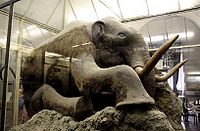Mammoth
 From Conservapedia
From Conservapedia | Mammoth | |
|---|---|

| |
| Scientific classification | |
| Kingdom Information | |
| Domain | Eukaryota |
| Kingdom | Animalia |
| Branch | Deuterostomia |
| Phylum Information | |
| Phylum | Chordata |
| Sub-phylum | Vertebrata |
| Infraphylum | Gnathostomata |
| Class Information | |
| Superclass | Tetrapoda |
| Class | Mammalia |
| Order Information | |
| Order | Proboscidea |
| Family Information | |
| Superfamily | Elephantoidea |
| Family | Elephantidae |
| Genus Information | |
| Genus | Mammuthus |
| Population statistics | |
Mammoths (Russian: мамонт mamont) are several extinct species of elephant belonging to the genus Mammuthus, characterized by large size, long curving tusks, and in a few examples, extensive body hair. All members of the genus were extinct by 2000 B.C., the estimated date of the last known mammoths on Wrangel Island, Russia.
Contents
Description[edit]
The average size of remains found indicates mammoths were as large as modern-day Asian elephants (Elephas maximus), approximately 9–10 feet at the shoulders and 4-6 tons in weight. The largest mammoth on record, M. imperator of North America, was 16 feet at the shoulders; of extinct mammals only the elephant-like Deinotherium and the hornless rhinoceros Indricotherium were larger.
Their teeth were high-crowned molars, as opposed to their contemporaries the mastodons, which had nipple-like features. Their tusks were long and curved inwards. Body hair, reddish-brown in woolly mammoths (M. primigenius), is known from the excellent cave paintings of Spain and France, as well as frozen individuals found in the Siberian and Alaskan permafrosts. In 2009 a nearly complete mammoth skeleton was found in downtown Los Angeles. Evolutionists, using unreliable radiometric dating, have calculated a date of 10,000-45,000 years before present as the age of this fossil.[1]
Species[edit]
- African mammoth, Mammuthus africanavus
- Columbian mammoth, Mammuthus columbi
- Imperial mammoth, Mammuthus imperator
- Jeffersonian mammoth, Mammuthus jeffersonii
- Pygmy mammoth, Mammuthus exilis
- Sardinian dwarf mammoth, Mammuthus lamarmorae
- Songhua River mammoth, Mammuthus sungari
- South African mammoth, Mammuthus subplanifrons
- Southern mammoth, Mammuthus meridionalis
- Steppe mammoth, Mammuthus trogontherii
- Woolly mammoth, Mammuthus primigenius
Origins[edit]
According to Baraminology, mammoths (and related the Mastodons) were part of the elephant Holobaramin and were descended from the two elephants present on Noah's Ark. Mammoths therefore represent descendents of the two survivors of the Flood, which migrated to various parts of the world. The long hair and other minor anatomical features that separate mammoths from living elephants are adaptations to local environments, predicted from Baramin theory.
References[edit]
Categories: [Mammals] [Extinct Animals] [Prehistoric Mammals] [Proboscidea]
↧ Download as ZWI file | Last modified: 03/23/2023 08:21:39 | 8 views
☰ Source: https://www.conservapedia.com/Mammoth | License: CC BY-SA 3.0
 ZWI signed:
ZWI signed: KSF
KSF